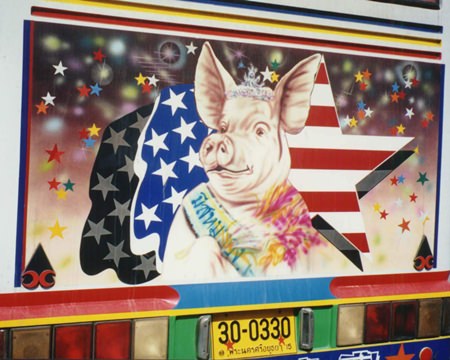There should be almost as much work in thinking about a photograph as there is in taking it. Great shots do not just ‘happen’, great shots are designed and planned for.
One simple way of developing the photographic eye is to give yourself a photo project. This makes you think about how to present the subject of your project. Bright and sparkly or dark and somber, for example.

This definitely works, and is something I have practiced all my life as a pro photographer. It was through my experience as a photographer able to handle projects that got me a contract to shoot calendars for a big construction company, and even to illustrate a promotional book for a hotel, which wasn’t even built. (That was something that really took some forethought.)
I am proposing that you should embark on an art project this week. What brought that to the forefront of my brain was the bus parking lots which all roads in Pattaya have become. I won’t get into discussions about whether busses should or should not be allowed into the CBD (they shouldn’t) but having so many of them handy, makes a good project.
Yes, so many of the busses have amazing art work, that makes them the ideal “canvas” for an art project. In a country where ‘copy’ art reigns supreme, there is still an adequate repository of art ready to be recorded by any keen photographer – and that is on the side of busses. Thai busses are wonderfully painted, gaudy bucolic beasts that roar along the highways blowing small vehicles from their paths as they thunder through. I had started a small photo project of my own, to record some of the incredible paintings on the sides and tails of these busses. 500,000 baht busses with 10 million baht paintwork.
However, if you want to begin one of these photo projects and feel free to continue with my busses, you have to have a camera with you and ready. This has also been one of the subjects I have covered before, calling it “Be Prepared” (with apologies to the Boy Scouts Association), if you save some articles.
To take these shots I used a polarizing filter to decrease reflections and also bracketed in half stop increments over three exposures. If you miss your bus shot, by the time you go back, it will have gone, so it is best to cover all the bases! And it is worthwhile using the polarizer to richen up the colors.
Some of the artwork on these busses is well worth enlarging and framing. And the end result could even be a photo display in one of the more ‘arty’ restaurants around town. Photo projects, as I have said previously, are a good idea to stimulate your creative self, but think about then expanding your project to include friends, relatives and acquaintances, you can pool thoughts and techniques to improve your own results. Just cultivate your enquiring nature and look for photo opportunities everywhere.
However, it is important that you do not let yourself be caught up in an ethical problem while getting your shots.
Photojournalists can have a problem with morality and ethics. The following test shows just how much stress there can be for the photographer. For example, here is the situation: You are in London. There is chaos all around you caused by severe flooding. You are a photojournalist working for a major newspaper and you are photographing this epic disaster.
Suddenly, you see a man in the water. He is fighting for his life, trying not to be taken down with the debris. You suddenly realize who it is… it is a well known violent criminal on the run. You notice that the raging waters are about to take him under.
You have two options:
(1)You can save the life of this man – or –
(2) You can shoot a dramatic Pulitzer Prize winning photo, documenting the death of one of the country’s most despised, evil and powerful men!
Now the question, and give an honest answer (nobody can see you)! Would you select high contrast color film, or just go with the classic simplicity of black and white?




